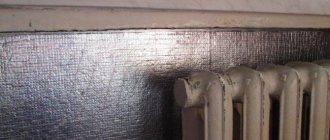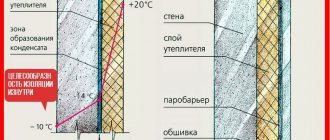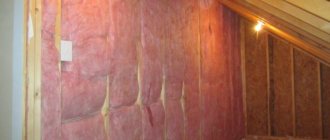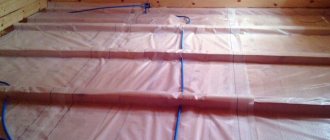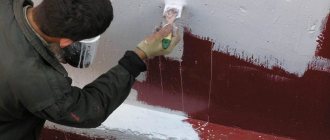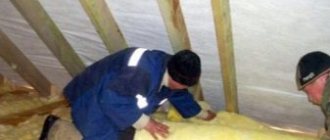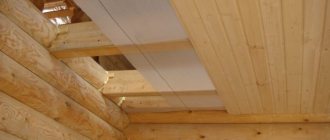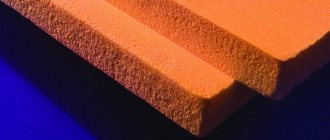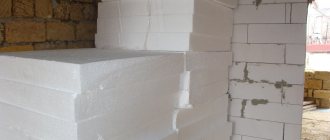An important stage in the construction of any house is waterproofing the wall. There are several types of this work, intended for external or internal processing of certain premises. Each facade material requires its own nuances in protection from water. Let’s try to figure out how to choose waterproofing and why it is needed at all.
Why is waterproofing needed?
- So that the house lasts as long as possible. Dry walls are strong walls. Water makes even the most resistant materials brittle and pliable. A house without waterproofing lacks proper strength and will very soon become uninhabitable.
- To make it warmer. Damp walls become cold in winter. The accumulated moisture freezes. The house becomes not a shelter from the cold, but, on the contrary, a kind of icy “ilgu”. The owners undertake to insulate the walls and additionally heat the room, spending a lot of money on it. Or you could simply protect the walls from water.
- So that there are no pests. The main one is fungus. It not only destroys walls, but also harms the health of residents. Dampness in the house, together with flowers, is the cause of constant poor health, chronic runny nose and more serious problems. Black spots on the walls are not only unsightly, but also dangerous.
As you can see, waterproofing is not just about “making the house better and stronger.” This is an important stage of work, an irresponsible attitude to which is fraught with serious consequences. By correctly installing waterproofing, the owner will automatically get rid of many headaches. We'll tell you how to do this later.
Do-it-yourself internal wall insulation ↑
For all rooms that are located below ground level or have high humidity, use coating waterproofing of internal walls. In small private houses, it is quite possible to do waterproofing yourself.
Work order:
- Leveling the surface using cement-sand mortars.
- Primer.
- Applying the main layer of coating waterproofing. (Recommended materials: Cemizol 2EN, Izofol Flex, Cemizol 2EP, Izofol).
- The adjacent walls are treated with waterproofing tape.
- Installation of decorative coatings (tiles, panels, etc.).
Applying waterproofing tape at wall joints
Where is waterproofing needed?
If the interior walls of the apartment are not protected, then some surfaces in the houses must be covered with waterproofing materials.
Mandatory processing:
- External walls. Everything is very simple here. Due to regular exposure to moisture, walls begin to lose their strength. An environment for fungi and insects is formed. Over time, unprotected walls will begin to rot. The moisture with which the material is saturated will sink down and gradually destroy the foundation.
- Basement. The basement walls suffer the most. The load on them is colossal: the weight of the house itself, wet soils, the proximity of groundwater, seasonal heaving of the soil. Any basement definitely needs protection and strengthening.
Under no circumstances should you insulate a basement without first installing waterproofing. And both internal and external!
- Places of high humidity. Here you need to waterproof the walls from the inside. The bathroom and kitchen are the wettest places in the house. The bathroom is a favorite place for fungus. You can get rid of dark spots on the seams between tiles. But what if the fungus is already deep in the wall? Wet and always warm kitchen walls are an excellent haven for cockroaches.
In damp areas of the house, it is appropriate to use materials that provide vapor barrier.
Will internal waterproofing of walls give results?
Insulation paint masks the fungus, but it doesn’t go away.
As we have already said, when moisture appears on the inside of the walls, you need to deal with the cause of its appearance. Let us immediately note that such events cost a pretty penny. There are cases when, for some reason, it is impossible or impractical to carry out capital measures to eliminate orphanage. Then you can resort to applying waterproofing to the walls from the inside, and use insulating paint as the material.
According to reviews, a layer of a few millimeters of paint with ceramic vacuum spheres helps prevent mold on interior walls. It works as insulation, but does not allow steam or water to pass through. The same applies to waterproofing walls inside the house, but again, only if absolutely necessary. By the way, any material that does not allow moisture to pass through is suitable as waterproofing.
Waterproofing is the ability of one of the layers of a building’s structural elements to retain moisture. The point is in the properties of the material, not in its name.
Internal waterproofing of walls in an apartment can be an auxiliary measure to the main work carried out outside the premises. In this case, the following materials are very effective:
- bitumen and latex mastics;
- coating compositions – waterproofing solution for cement-based walls;
- silicone sealants;
- impregnation;
- cement based plaster.
The same materials are used in bathrooms for the internal treatment of vertical and horizontal surfaces. In this case, it is not necessary to apply them in a continuous layer from floor to ceiling; it is enough to treat only the places where there are communication outlets. These include the bathroom, toilet and bidet areas, as well as sinks.
It is quite difficult to repair a heating circulation pump on your own, without specialized knowledge. Still, it is better to entrust this matter to specialists.
Learn more about repairing bimetallic heating radiators with your own hands here.
How to properly waterproof?
We have already found out that without her we can’t go anywhere. This means that absolutely all houses undergo the process of protection from moisture. But why are some dry and reliable, while others fall apart? The answer suggests itself: not all waterproofing is effective. Incorrect or low-quality work is the same as its absence.
How can I make this work?
- Buy only high-quality materials: choose trusted manufacturers and remember that building materials, like food, have an expiration date. More expensive is not always better, but a good waterproofer will never be too cheap.
- Hackwork is unacceptable. Under no circumstances leave cracks, gaps, or weak points. If the waterproofing is done by a team, carefully monitor the quality of the work. Are there any flaws? Make it change!
- Choose the material that is best suited for your walls. What is the best way to cover a particular house is in the next paragraph.
- Don't ignore the instructions. It was said not to install this waterproofing in winter - wait until spring.
- It's not worth saving. Do moisture insulation wherever necessary. Don't expect a smaller layer of solution to be as effective.
How to get rid of dampness, technique
Often, the room is humid due to the low thermal resistance of the enclosing structure.
We have already listed all the possible causes of dampness and determined that, with the exception of the bathroom, waterproofing of the walls outside will be required. There are many methods and materials and they differ depending on the problem. Let's start with the fact that water can get onto the facade by flowing from the roof. If we are talking about an apartment, then the solution may be to apply a waterproofing mixture to the walls from the outside.
In Russia there is a state program for insulating facades with paint containing ceramic microspheres. This material is quite suitable for protection against moisture. If the structural elements of the house are made of concrete, then various impregnations can be used both inside and outside. It should be borne in mind that such compositions are unsuitable for waterproofing brick walls, since the pores in brick are much larger than in concrete.
In a private house, moisture can reach the walls either directly from precipitation or rising from the foundation. Therefore, in addition to the above measures, you need:
- waterproof the foundation;
- arrange a drainage layer around the perimeter of the house;
- lay waterproofing under the blind area.
The main task is to remove moisture into the ground, preventing it from contacting the structural elements of the building.
If there is a leak at the junction of walls with horizontal ceilings, then it is enough to waterproof the junction of the floor (ceiling) and the wall. In panel houses, water can collect in the slab itself. The concrete panel consists of two layers of hardened mortar, between which there is insulation. Moisture first collects in the insulation, and when it finally breaks down, cavities form. Several buckets of water can accumulate in such cavities. To release it, you need to drill holes from below. It will take years to dry on its own.
Often mold and moisture are the result of improper or insufficient insulation. Laying thermal insulation from the inside leads to a transfer of the dew point to the middle of the room. The insulation should always be outside. It is important to calculate the thickness of the thermal insulation layer so that the dew point is in the insulation.
Types of waterproofing
Let's consider the types of waterproofing that are currently used in construction.
Injection waterproofing
Complex, but effective. The wall is impregnated with a hydrophobic substance throughout its entire thickness, closing the slightest pores. To do this, passages are drilled along the entire wall, where the substance is injected through a pump. They perforate the walls from the inside - but as a result, the protection is double-sided, which is very convenient.
Where is it used? This type is popular when working with brick and concrete walls. It is the best option for a country house. Injection waterproofing is also used for the basement: to protect the walls on all sides, there is no need to dig up the house from the outside.
Pros:
- materials for injection waterproofing are environmentally friendly;
- monolithic protective layer without joints;
- uniform and reliable insulation throughout the entire thickness of the wall.
Minuses:
- price;
- difficult technology.
Materials. Injection waterproofing is made with acrylate and hydroactive gels, epoxy polymers, cement-sand compositions, and silicate-based products.
Penetrating waterproofing
The process is simple: covering the wall with mortar. And he himself will do everything “for you.” The distinctive feature of this method is indicated by the name itself: protective substances penetrate tens of centimeters into the wall, creating a thick and strong protective layer.
Where is it used? This is an option for concrete, reinforced concrete and brick. This method does not work with foam concrete. The main area of use is vertical waterproofing of walls.
Penetrating agents are not suitable for walls with significant voids or cracks.
Pros:
- non-toxic;
- durability;
- effective protection against aggressive environments.
Minuses:
- high price of materials;
- does not protect against pressure leaks.
Coating waterproofing
Involves covering surfaces with mastics. The mastic forms a strong waterproof film that tightly closes the smallest pores.
You don’t need any special skills to apply the mastic - you will need a regular roller for this. However, you should “spread” the material carefully and without gaps. Be sure to take breaks between approaches: do not take on a new layer until the previous one has dried.
Where is it used? This method is often used in the finishing of reinforced concrete, concrete, and metal structures. Widely used in waterproofing non-residential premises.
Pros:
- ease of operation;
- low price.
Minuses:
- wears out quickly;
- spoils due to sudden changes in temperature.
Materials. “Coating” is done with various types of mastic: bitumen, polymer rubber.
Might be interesting
Waterproofing
Foundation waterproofing: optimal choice of technology
Waterproofing
Clean water is the key to health, waterproofing concrete…
Waterproofing
Instructions for waterproofing a swimming pool
Waterproofing
Selection of materials, methods of waterproofing work...
Sprayed waterproofing
This is the application of liquid rubber by spraying. The desired surface is cleaned, primed and covered with material. The rubber layer provides 100% protection from moisture.
Where is it used? Rubber walls are not for residential premises. Sprayed moisture protection is most often used in basements and roofs.
Liquid rubber is the only “save” for basements in places with high groundwater levels.
Pros:
- strong rubber adhesion to almost any material;
- absolute waterproofness;
- speed of work.
Minuses:
- high price;
- the need for special tools for coating;
- the material does not allow air to pass through at all.
Today, spraying liquid rubber is completely fireproof.
Pasted waterproofing
Its essence is to cover the wall with bitumen material: panels, sheets or rolls. The task is to eliminate all the unevenness of the wall, prepare the surface and attach the insulator. The glue is often mastic.
Where is it used? The classic use of this method is to insulate foundations and basements. Often, bitumen sheets - for example, roofing felt - are used to cover the roof.
Pros:
- quick covering of even the largest surfaces;
- ease of use;
- strength - materials can withstand heavy loads;
- high degree of vapor barrier;
Minuses:
- not suitable for hard-to-reach places;
- waterproofing cannot be done in winter;
- Can not be repaired.
Materials: bitumen cardboard, varieties of hydrosol, bitumen-polymer products: isoelast, technoelast.
When using adhesive waterproofing, an overlap must be observed - at least 10-15 cm.
Film waterproofing
Everything is simple here: wrap it with film - no water will get in. Waterproofing the walls of residential premises is not done with film - it does not allow air to pass through at all. This material is used to protect roofs, foundations, and floors.
If you insulate the foundation with film, you definitely need a geotextile backing. As with the previous method, overlap is required. The seams should be carefully secured with tape.
Don't expect cheap film to last long. Of course, the material does not allow water to pass through. There is another disadvantage - it breaks easily. Cheap polyethylene can be laid in two or three layers - but sometimes this does not help. High-quality waterproofing film is expensive.
A progressive method of film waterproofing is the use of a membrane. This is a polymer material that does not allow moisture to pass through, but can also breathe. At the same time, the membrane provides an effective vapor barrier.
Pros:
- efficiency;
- durability;
- ease of installation;
Minuses:
- breaks;
- requires additional training;
- high price of good film;
- additional costs for the substrate.
Painting waterproofing
This is basically protecting the walls from the inside. It’s easy to do: paint the desired surfaces with special waterproof paint.
Where is it used? This type of waterproofing is used more often indoors, but is sometimes used outside, to seal seams and cracks.
Pros:
- quick and easy application;
- vapor permeability;
- has anti-corrosion properties;
- abrasion resistance.
Minuses:
- short-lived.
Preparing walls for waterproofing
In order for the protective layer of the walls, inside or outside, to last as long as possible, it is important to prepare the surface. This includes the following list of works:
- Removing old finishing material from the walls (if any): plaster, tiles, paint, wallpaper. Tools: metal brush, spatula, chisel, chemical compositions for removing paint, hair dryer or sandblaster.
- Eliminate wall defects: cracks, crevices, depressions and protrusions, remove protruding foreign objects and nails.
- Cleaning concrete, wood or brick walls. This includes removing grease stains, removing dirt and dust.
- At the end, prime the wall in two layers with breaks for drying. This will improve the adhesion of the waterproofing to the surface.
Now waterproofing of brick or concrete walls can be carried out according to the instructions given for each material. The mastic is applied in several layers, the rolled material is glued to the mastic or melted to the surface (to prevent moisture from passing through the joints, an overlap of 10–15 cm is made).
If you are waterproofing wooden walls, then in addition to standard surface preparation, it is important to additionally treat it with antiseptic compounds so that the wood does not rot.
Waterproofing wood. What are the features?
How to protect a wooden house from moisture? After all, he needs protection much more than others. Wood, even dried and processed, is a natural material subject to rotting and deformation.
To prevent the wood from deteriorating, it should be treated with a number of protective agents: an antiseptic - a solution against pests, a fire retardant - a fire-resistant compound, a protective varnish and, of course, a waterproofing solution. There are dual-action drugs: for example, an antiseptic that protects against water ingress. You can also find products that only protect against moisture.
There are two types of wood protectants: penetrating and film-forming. The first are more durable, as they create a fairly thick waterproof layer inside the wall. Film-forming materials are more susceptible to mechanical damage. Over time, the crust peels off. It is worth updating the coating regularly.
In a wooden house, both external and internal waterproofing of walls is required. To treat the inside of a room, it is recommended to use products that are less aggressive in composition.
Types of waterproofing materials
According to their purpose, materials are divided into 4 types:
- sealing;
- anti-corrosion;
- hydro- and heat-insulating;
- antifiltration.
In appearance, waterproofing can be liquid or roll.
An example of using rolled waterproofing
Bitumen mastic
Bitumen is an elastic mass that is a product of oil refining. Creates a dense waterproof film on the surface and is not subject to cracking. Fills the smallest cracks, penetrates into the pores of the base. Used in combination with roll material or independently. Designed to protect the wall from the outside and treat the foundation.
Bitumen mastic is easy to apply; even a person with no experience can cope with the task. The work takes a little time. The material is sold in the form of bars, which must be heated to 150 degrees to melt before use.
The disadvantages include the duration of hardening. If low-quality compounds are used, the resulting coating may crack over time.
Polymer mastic
Polymer mastics are acrylic-based plastic adhesive compositions used for waterproofing walls from the inside or outside. In addition to protection from moisture, it improves the thermal insulation properties of the treated surface.
Advantages of polymer mastic:
- forms a dense, even coating that does not require finishing;
- fireproof;
- protects against moisture, fungus, moss;
- has a safe composition that allows its use in bathrooms and other rooms;
- Available in a wide range of colors;
- resistant to sub-zero temperatures;
- dries quickly;
- elastic, when the base dries or deforms, it retains its integrity.
Colored polymer mastic
Deep penetration compositions
Dry mixtures containing quartz sand, cement and polyurethane resins are diluted with water immediately before use. After drying, they form an airtight film that reliably protects the surface.
The application technology is extremely simple; the work can be performed by a non-specialist. Penetrating compounds are used primarily inside the home.
Roofing felt and roofing felt
Both materials are used to waterproof the outside of the wall and protect the foundation from moisture.
Ruberoid is a rolled material consisting of a base (cardboard, fiberglass) and impregnation (most often bitumen). Roofing felt is a cardboard sheet impregnated with a tar composition. The first is superior to the second in its properties; only it costs less.
Membrane (film)
It is a roll material made of synthetic rubber or PVC. Used indoors and outdoors. A significant drawback is instability to mechanical stress. Waterproofing film for walls can easily be damaged during installation.
Covering the foundation wall with a membrane
Injection waterproofing
This type includes:
- epoxy compounds;
- acrylate gels;
- polyurethane compounds.
Holes are drilled in the wall in increments of 50 cm into which liquid is injected under high pressure. The method is quite expensive and requires special equipment, so its use is justified only in very complex cases when it is impossible to use other materials.
How long will waterproofing last?
Everything wears out over time, including the waterproofing coating. The protective layer can slowly but surely deteriorate, losing effectiveness. One day the coating will need to be updated.
How durable is the protection of walls from moisture using various methods:
- Waterproofing films will last up to 50 years - however, if they do not break.
- Injection and penetrating waterproofing are among the most durable. They will faithfully protect your home for 20 years or more.
- Waterproofing with liquid rubber is reliable, but over time it can become weak.
- Mastic is not durable - after 5-10 years its layer will need to be renewed.
- Wooden wall treatments wear out the most. It is necessary to repeat every 3-5 years.
- Regularly refresh the hydrophobic coating of the facades of your house: it can also crumble over time.
Often, installing new waterproofing is problematic due to the finish. Many owners of private houses neglect major repairs: everything is still in order, the house is not falling down - why strip it and refinish it? You need to be careful here. When the house starts to crack, it will be too late to install waterproofing.
Types of materials and methods of waterproofing walls ↑
Recently, underground space has been actively used, where excess moisture is also explained by uneven soil pressure, shrinkage of walls and foundations. Having penetrated into the basement, water easily rises along an unprotected wall into the living space. To avoid these phenomena, steam and waterproofing of walls is simply necessary.
To prevent moisture from precipitation, groundwater and general humidity from harming buildings, and to prevent mold and mildew, walls are waterproofed.
Important: There are special rules according to which waterproofing of walls is carried out - SNiP (regulatory documents establishing requirements for waterproofing compounds, sealing mixtures, as well as technological operations).
Wall waterproofing
Waterproofing of external and internal walls is carried out using the following types of materials:
- Expanding cement - as the mixture hardens, it expands in volume, filling joints and cracks.
- Penetrating mixtures, this can be liquid glass, bitumen-containing materials, cement, granulometric quartz sand with chemically active additives. Can be used outside and inside the building.
- A waterproofing membrane is a specific polyethylene film of different densities with antioxidant and other components that improve technical characteristics. The thickness of the canvas can vary from 0.5 to 3 mm. The densest membranes are less elastic.
Please note: To protect the wall from exposure to acidic and alkaline environments, injection materials are used if necessary.
The waterproofing membrane is quite durable (up to 50 years), resistant to oxidation and rotting, and not subject to corrosion.
Waterproofing walls from the inside and outside is carried out in the following ways:
- Horizontal waterproofing is an effective and inexpensive method in which, after trimming the walls in a horizontal plane, the resulting space is filled with waterproof materials. In some cases, an injection method is used, in which the capillaries are blocked and the walls become hydrophobic.
- Vertical waterproofing is less effective, since, while preventing moisture from penetrating into the building, it cannot completely protect the walls from rising moisture in height, creating a favorable environment for the occurrence of fungus. This method is used more effectively in complex (horizontal-vertical) events.
Waterproofing with profiled membrane
When considering materials for waterproofing walls from the inside of a room, you should pay attention to a profiled membrane, which has many advantages, among others, a long service life that reaches 50 years should be highlighted. In addition, the material is resistant to ultraviolet radiation, safe for the external environment, human health, and retains elasticity when changing temperatures. The membrane is non-corrosive and resists low damage and chemical elements.
This method of waterproofing is also good because it is economical, because you do not need to spend effort and money on concrete work. Installation is quite simple, so the work can be completed efficiently and quickly, especially during repairs. Waterproofing indoor walls with a membrane has one more nuance: films are more often used to eliminate excess moisture in basements. They are presented in the form of rolls. But if you want to carry out waterproofing work in a toilet, bath or shower, then it is better to use elastomer membranes in liquid form. The layer is durable and elastic, it has no seams, and is applied with a roller, brushes or in the form of a plaster mixture under tiles or gypsum panels. An example of a liquid membrane is ISOMAT SL 17.
